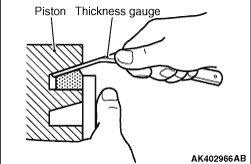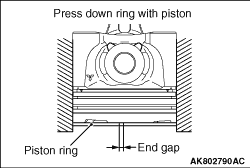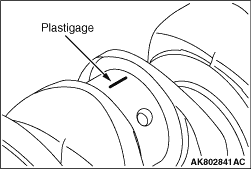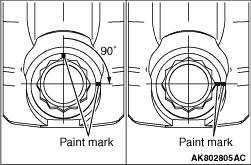

| note | In cases of keystone type, measure the ring to groove clearance as shown. |
- No. 1 ring: 0.08 -
0.12 mm
No. 2 ring: 0.08 - 0.12 mm
Oil ring: 0.02 - 0.06 mm
- No. 1 ring: 0.15 mm
No. 2 ring: 0.15 mm
Oil ring: 0.10 mm
PISTON RING |
 |
2.Put piston rings into the cylinder bore, press them against the piston top face, and push
them in. After achieving squareness, measure the end gap with a free gauge. If the end gap is
excessive, replace piston rings. Standard value:
No. 2 ring: 0.20 - 0.35 mm Oil ring: 0.25 - 0.45 mm |
CRANKSHAFT PIN OIL CLEARANCE (PLASTIGAGE METHOD) |
| 1.Wipe oil off the crankshaft pin and connecting rod bearing. |
| 2.Place a plastigage in length equal to the bearing width on the pin shaft straight
in alignment with the shaft centre. |
 |
3.Carefully install the connecting rod cap. 4.Apply the engine oil to the bolt thread portion and the seat surface before tightening the bolt. 5.After finger-tightening each bolt, alternately tighten the bolts to correctly install the cap. 6.Tighten the bolt to the torque of 5.0 N·m. 7.Tighten the bolt to the torque of 20 N·m. |
 |
8.Put the paint mark to the bolt head, as shown in the illustration. 9.Put the paint mark on the connecting rod at 90° position in the tightening direction of the bolt, based on the paint mark position of the bolt.
11.Remove bolts and gently remove the connecting rod cap. |
 |
12.Measure the crushed plastigage width (area most widely crushed) using a scale printed
on the plastigage bag. Standard value: 0.026 - 0.053 mm Limit: 0.1 mm |